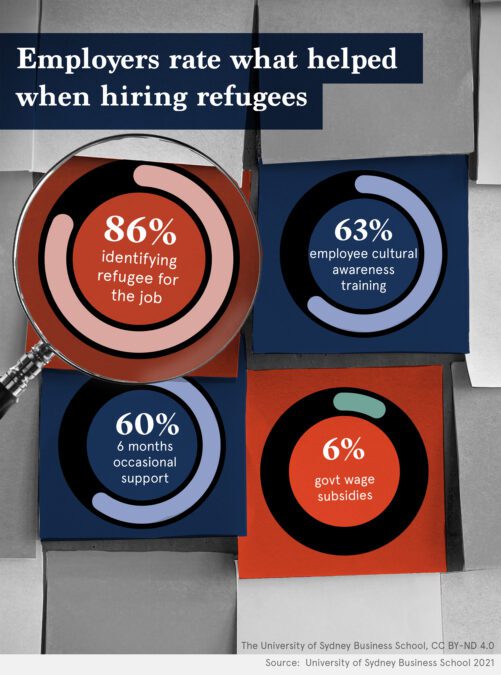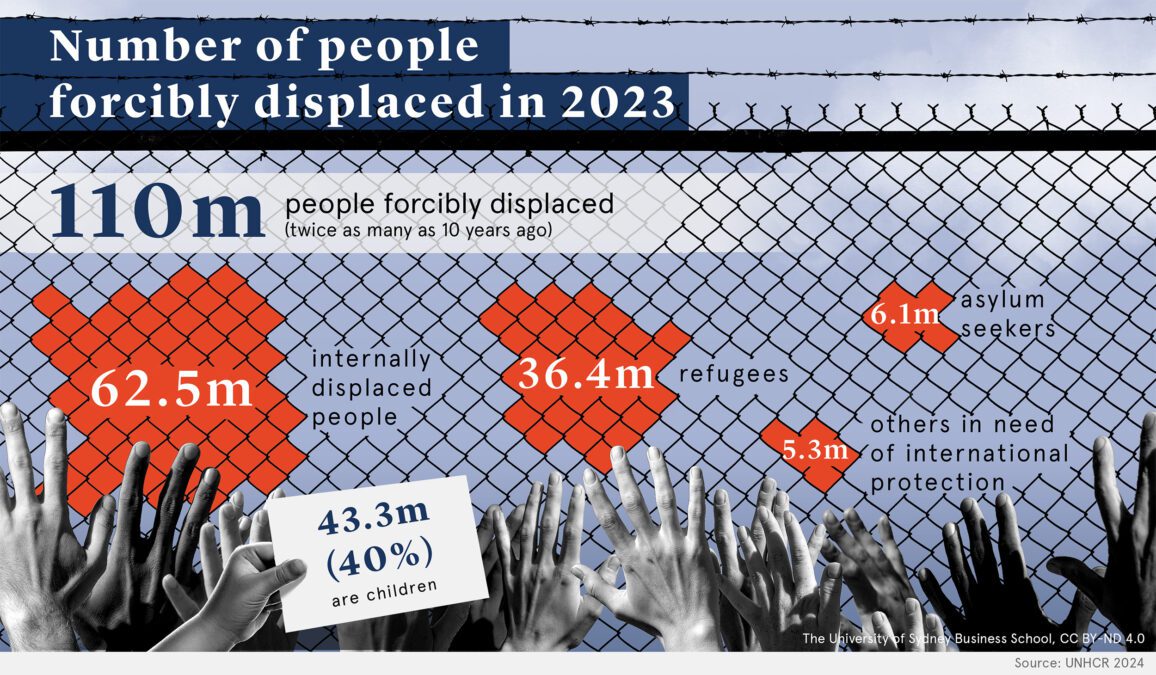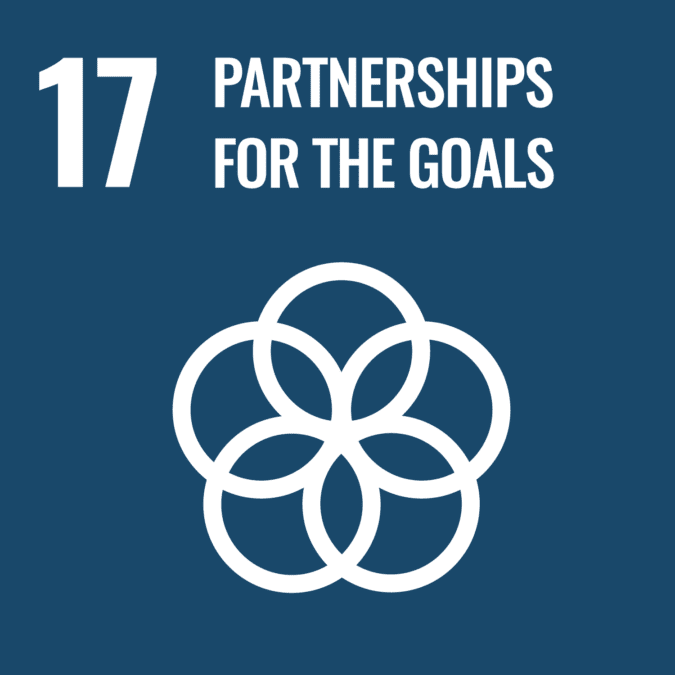Betina Szkudlarek

SDGs by 2030 – are we on track?
Partnering for refugee employment
When considering their talent pipelines, few companies think outside-of-the-box. Most follow their conventional recruitment strategies, targeting the usual pool of talent.

This shortsighted approach can overlook whole groups, such as refugees, leaving them out of the corporate recruitment processes. Certainly, many refugees don’t come armed with local references, recognised qualifications or local experience. But our research shows that when given the opportunity, most refugees flourish in the workplace, and so do the businesses that hire them, along with the employees working alongside them.
Our research team tapped into the many misunderstandings and erroneous assumptions many employers hold about refugees. We found that employers who have not hired from this talent group vastly overestimate the challenges, and underplay the benefits, of refugee recruitment. Conversely, employers who hire refugees reported pay-offs in terms of employees’ strong work ethic, high productivity and good morale.
Moreover, the positive impact expands across the whole workforce as local employees often discover a new meaning to their work through building relationships and learning from people from a refugee background.
Our research into refugee employment links to SDG 17 (Global Partnerships) in that successful recruitment and retention of people from a refugee background into local businesses requires support from multiple parties. The necessary partners are employers, social enterprise organisations, and governments.
Non-government organisations that help settle refugees are not in a position to offer them employment. However, Non-Government Organisations play a critical role both in preparing refugees to flourish in their new work environment, and also supporting companies to effectively onboard refugees.

Organisations that do want to diversify their talent pool frequently don’t know how to locate refugees. They will likely require assistance in transitioning individuals into a new work environment, and in preparing the local workforce to embrace diversity.
Governments need to set the policy parameters to ensure workplaces are ready to employ people from a refugee background. Refugees should not be viewed as a form of cheap, transient labour. They are not backpackers passing through looking to supplement their travel budgets. They are committed to their families and communities and need decent pay and scope for advancement.
When these parties collaborate effectively, refugees gain employment opportunities and the chance to rebuild their lives in a new country, while employers benefit from acquiring valuable workers.
Everyone who hires someone from a refugee background creates a transformative effect for the family of that person, for their own organisation and for their wider community.
Sustainable Development Goal (SDG) targets addressed:
Target 17.16 Enhance the Global Partnership for Sustainable Development, complemented by multi-stakeholder partnerships that mobilize and share knowledge, expertise, technology and financial resources, to support the achievement of the Sustainable Development Goals in all countries, in particular developing countries
Target 17.17 Encourage and promote effective public, public-private and civil society partnerships, building on the experience and resourcing strategies of partnerships
Resources
Student assignment
Inclusive Leadership
Objective: Explore challenges and potential solutions to inclusive leadership in the workplace.
Video Questions: Pre-screening sample questions:
- What are the challenges faced by people from a refugee background and other migrants in finding employment in their new country?
- In your view, why should leaders engage in proactive hiring of immigrants, including people from a refugee background?
- What makes a company’s recruitment processes inclusive? What hinders inclusiveness?
- What does inclusive leadership mean in practice? What specific examples of inclusive leadership in action are you familiar with?
Video: Watch the “Inclusive Workplaces: Employment is Life” video or the entire set of “Inclusive Workplaces” videos.
Post-screening questions:
- What are the key takeaways from the video?
- What best inclusive employment practices have you heard of?
- What else could leaders do to make their organizations more inclusive?
- What personal actions can you take to advance a supportive and inclusive environment in your teamwork? How can you lead inclusion?
- Who and how can employers partner with to advance their inclusive strategy?
Assignment:
Your team of consultants has been engaged to review the level of inclusion practices among new incoming and current employees at a client [1]organization. Your assignment involves three tasks:
1) assess what policies and practices are in place in this organization in support of an inclusive work environment;
2) design an evaluation tool to evaluate whether these policies and practices are effective; and
3) decide who the organization can partner with and in what way to increase their inclusivity?
Q1. What corporate practices would you look for to assess the organization’s inclusivity culture and practices? Consider both the reactive practices (i.e., those focused on the elimination of discrimination), as well as the proactive ones (i.e., those focusing on enhancing the climate of inclusiveness and belonging for everyone).
Q2. For each identified practice, how would you assess its effectiveness? What would you measure to understand whether the organization is truly inclusive?
Q3. What specific actions could be taken by leaders to increase corporate inclusiveness?
Q4. Who and how can the organisations partner with to achieve better outcomes?
Q5. Which of these learnings can you apply in your own teamwork?
[1] Students can choose an organization, or the teacher can assign an organization that students should investigate.
Further reading
Articles
- Lee, E. S., Szkudlarek, B., Nguyen, D. C., & Nardon, L. (2020). Unveiling the canvas ceiling: A multidisciplinary literature review of refugee employment and workforce integration. International Journal of Management Reviews, 22(2), 193-216.
- Szkudlarek, B., Roy, P., & Lee, E. S. (2022). How Multinational Corporations Can Support Refugee Workforce Integration: Empathize Globally, Strategize Locally. AIB Insights, 22(3), 1-5.
- Szkudlarek, B. (2019). Engaging Business in Refugee Employment. The Employers’ perspective. The University of Sydney Business School.
Video
Website
Reports
Betina Szkudlarek is Professor of International Management at the University of Sydney Business School. Her core research expertise lies at the intersection of International HRM, Global Leadership and Diversity Management.
Share
We believe in open and honest access to knowledge.
We use a Creative Commons Attribution NoDerivatives licence for our articles and podcasts, so you can republish them for free, online or in print.




